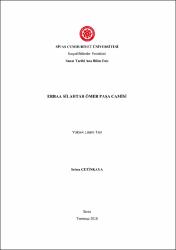| dc.contributor.advisor | Eser, Erdal | |
| dc.contributor.author | Çetinkaya, Selma | |
| dc.date.accessioned | 2020-02-27T09:09:40Z | |
| dc.date.available | 2020-02-27T09:09:40Z | |
| dc.date.issued | 2019 | tr |
| dc.date.submitted | 2019-07-04 | |
| dc.identifier.other | xix, 122 | |
| dc.identifier.uri | https://hdl.handle.net/20.500.12418/12303 | |
| dc.description.abstract | Silahtar Ömer Paşa Camisi, Tokat’ın Erbaa İlçesinin Akça (Fdi) Köyünde
yer almaktadır. Yaklaşık olarak kareye yakın dikdörtgen bir forma sahiptir. Caminin
inşa kitabesi günümüze gelemediğinden dolayı tarihlendirme bir kaç kaynak
doğrultusunda yapılabilmektedir. İnşa tarihine ait bilgiler şu şekildedir; Ceylan derisi
üzerine yazılmış levha, Silahtar Ömer Paşa tarafından camiye hediye edilen iki bakır
şamdanın üzerindeki kitabe ve caminin bakım ve onarımı için istenen vakıf
belgesidir. Ceylan derisinden levhanın üzerinde H.1087/M.1676, bakır şamdanların
kitabesinde H.1100/M.1689 ve vakıf belgesinde H.1119/M.1908 tarihleri yer
almaktadır. Caminin mimari-süsleme özellikleri ve elde edilen tarihler neticesinde
caminin 17. yüzyılın ikinci yarısında yapılmış olabileceğini söyleyebiliriz.
Giriş mekanındaki revakların arasında üçgen sivri açıklıklar bulunmaktadır.
Giriş mekanı “U” biçimli bir forma sahiptir. Kalemişi süslemeler caminin giriş
mekanında yer alan sivri üçgen açıklıklarda, harim tavanında, minber köşkünde ve
kadınlar mahfilinde karşımıza çıkmaktadır.
Cami, ahşap destekli ve tavanlı cami mimarisi içinde kalemişi süslemeleri ile
birlikte özel bir yere sahiptir. | tr |
| dc.description.abstract | Silahtar Ömer Paşa Mosque is located in Akça (Fidi) village of Erbaa
District of Tokat. It has a rectangularshapethat is approximately closetosquare.
Because thein scription of the mosque cannot cometo present, its date has been made
in accordan cewith several sources. The construction dateinf ormation is as follows;
Theplatewritten on gazelle leather is a foundation certificatere questedfort he
inscription on two copper candlesticks presented tothemosqueby Silahtar Ömer Paşa
and the maintenanceand repair of the mosque. The reare Hijri 1087 / Gregorian 1676
on theplate of Ceylan leather, Hijri 1100 / Gregorian 1689 in theinscriptions of
copper candlesticks and Hijri 1119 / Gregorian 1908 in the foundation document.As
a result of the architectural and decorative features of the mosque and the dates
obtained, it can be said that the mosque may have been built in these condhalf of the
17th century.
There are sharp triangular spacings between the porticoes at theentrance.
Theentrance has a “U” shape. Hand-draw nornament sareseen in the sharptriangular
spacings in theentrancearea of themosque, in theceiling of thesanctuary, the
pulpitand thewomen's gathering place.
Themosque has a specialplace among the mosque architec turewith wooden
suppor tandceilings, with the hand-drawnornaments. | tr |
| dc.language.iso | tur | tr |
| dc.publisher | Sivas Cumhuriyet Üniversitesi-Sosyal Bilimler Enstitüsü | tr |
| dc.rights | info:eu-repo/semantics/openAccess | tr |
| dc.subject | Silahtar Ömer Paşa | tr |
| dc.subject | Akça (Fidi) | tr |
| dc.subject | Camii | tr |
| dc.subject | Ahşap | tr |
| dc.subject | Süsleme | tr |
| dc.subject | Kalemişi | tr |
| dc.subject | Tokat | tr |
| dc.subject | Erbaa | tr |
| dc.title | Erbaa Silahtar Ömer Paşa Camisi | tr |
| dc.type | masterThesis | tr |
| dc.contributor.department | Sosyal Bilimler Enstitüsü | tr |
| dc.relation.publicationcategory | Tez | tr |















